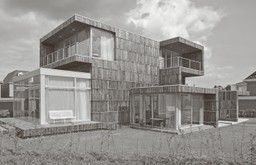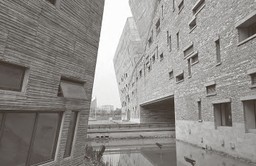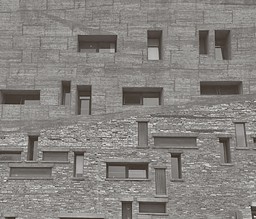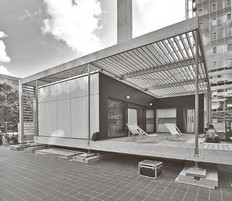In my favourite book, Operating Manual for Spaceship Earth, Buckminster Fuller (*1895 Milton, † 1983 Los Angeles) reflects on the Earth as a single spaceship, one so well designed that it allows for the regeneration of life even despite the phenomenon of entropy. According to Fuller, the Earth is a mechanical object much like a car – “and so we have to change the oil, fill up the fuel tank and put water into the radiator, to take care of it as a whole”[1].
Polluto or 10 problems of the natural environment
And yet it seems, at the threshold of the third millennium, that now this unique vehicle is starting to break down on us, and quite soon will need to be renamed “Polluto”[2]. The rising number of inhabitants on the planet and their striving for improved living standards is creating enormous pressure on the environment. Let us, to start, sum up the main problems facing us:
- climate change → the UN framework convention on climate change defines it as “a change of climate which is attributed directly or indirectly to human activity that alters the composition of the global atmosphere and which is in addition to natural climate variability observed over comparable time periods“. Climate changes are manifested in a variety of ways, including an increase in average temperatures, changes in samples of rainfall, unpredictable weather patterns or rising sea and ocean levels, caused by the melting of glaciers and polar ice caps[3].
- pollution → pollution of the natural environment as a result of human activities – the use of fossil fuels, industrial activity and agriculture – which have a negative impact on human health and natural biodiversity.
- disappearance of the ozone layer → a layer of ozone is present in the stratosphere at a height of 10-40 km and traps the majority of ultraviolet UV-B radiation arriving from the Sun. The disappearance of ozone is caused by the effects of compositions containing fluorine, chlorine and bromine, also released as a result of human activity. Thinning of the ozone layer leads to raised values of UV radiation on the level of the earth’s surface, which has an unfavourable impact on water and land ecosystems, the food chain, and human health. Among the negative influences on human health it is worth mentioning, e.g. skin cancer, cataracts, or damage to the immune system[4].
- resources → the gradual exhaustion of non-renewable natural resources. Estimated reserves according to British Petroleum: natural gas for 66 yeas, coal for 180 years, crude oil for 45 years. For renewable natural resources, their extraction is proceeding at an excessive rate.
- water – quality and quantity → unsustainable treatment of water resources 5 has led to critical shortages of water in several parts of the world. One in five people lacks access to safe drinking water, and the difference between the supplies of water and their consumption is growing ever greater. Water quality is negatively influenced by human activity, primarily the use of fertilizers and pesticides.
- deforestation → loss of forest cover occurs for many reasons – wood or charcoal being used as fuel or a cash commodity, cleared land being used for pastures, plantations or settlement. Destruction of forest growth without any subsequent replacement causes a disturbance to natural biotopes, a loss of biodiversity and soil aridity, as well as having a negative impact on the resistance of soil to erosion. Particularly in tropical regions, deforestation contributes significantly to emissions of CO2[6].
- soil degradation → urbanisation, construction, mining, armed conflict, agriculture and deforestation all lead to degradation of soils[7], a problem reaching from erosion and contamination of the upper soil layer to the excessive extraction and contamination of groundwaters. It may cause damage to natural biotopes and lower soil fertility, while changes in the infiltration capacity increase the risk of flooding. A loss of fertile soil lowers regional agricultural production, while soil carried away through erosion causes serious damage to water systems.
- waste → the world economy is grounded in the high consumption of raw materials[8] . In EEA member states[9] every year 4 tons of waste are produced per inhabitant, while every citizen of the EU annually is responsible for 520 kg of household rubbish. Liquidation of waste can have may negative impacts on the environment, including emissions into the atmosphere, surface waters or groundwater. Waste also represents a loss of natural resources. Treatment of waste is a source of greenhouse gases, primarily methane, and contributes to global climate change.
- biodiversity[10] → loss of biodiversity lowers the variety within biological species, reduces the number of species themselves, and may even increase the number of certain species that have lost their natural enemies. Human effects on the environment have led to a rapid reduction in biodiversity, even on the genetic level. “The main causes are changes in natural habitats. These are due to intensive agricultural production systems, construction, quarrying, overexploitation of forests, oceans, rivers, lakes and soils, alien species invasions, pollution and — increasingly — global climate change.”[11]
- population → the human population has been constantly growing since the period of the Black Death around the year 1400 CE. According to the UN, the population on earth has achieved 7 billion by 2011, and in 2050 is likely, according to various scenarios, to reach 7.4, 8.9 or 10.6 billion[12]. The economic imbalance between developed and developing nations is also a threat to the environment.
Climate changes
The question of the condition of the environment has often been narrowed to the debate over current climate changes. Over time, this debate has led to the emergence of two strongly opposing camps. The first is concentrated around the Intergovernmental Panel for Climate Change (IPCC)[13] and is convinced that current changes in the world climate are the result of an increasing concentration of greenhouse gases in the atmosphere. The second adheres to the belief that climate changes are a natural phenomenon, the result of growing solar activity.
In the course of the history of our planet, it is evident that colder periods (glacial, or ‘ice ages’) have long alternated with warmer ones (interglacial). At present, we are in an interglacial period, which tends to have a shorter duration than an ice age. According to the calculations of the Niels Bohr Institute, sudden changes of climate of 7 – 10 K every 1500 years are a natural part of variations in the climate system, and opponents of the theory relating CO2 concentration to global warming do ascribe the main role in this area precisely to an increase in solar activity[14].
On the other side of the debate, the IPCC stated in its Evaluation Report for 2007 (AR4)[15] that global temperature increases are up to 90% related to human activity, calculating that the rising temperature on the earth’s surface is the outcome of increasing concentrations of greenhouse gases in the atmosphere (primarily CO2 and methane), which is brought about by human activity such as deforestation, burning fossil fuels, and agriculture. The human population, currently equal to around 6.7 billion, annually produces 2.4 billion metric tons of CO2. Between 1800 and 2002, the concentration of CO2 rose from 280 ppm to 350 ppm, while in the same period the temperature rose by 0.8 K. Increased temperatures on the earth’s surface have had such effects as the melting of glaciers, the retreat of the snow cover and rising sea levels[16].
The 2K scenario
Recent research has indicated that over the past 150 years, solar activity had a connection to the surface temperature of the Earth for the first 120 years, yet for the past 30 years the curves for solar activity and surface temperature have differed substantially[17].
In reaction to the findings of the IPCC, the Copenhagen Accord has set as its long-term goal the lowering of the emission of greenhouse gases such that the earth’s temperature does not rise by more than 2°C. Research has indicated that to achieve this goal, it will be necessary to lower emissions of CO2 to 10 Gt/a by 2050, or in other words by 1 t of CO2 per person annually[18].
Yet even regardless of whether human activity is or is not a cause of global climate changes, it should be evident that human activity does have a negative influence on the state of the natural environment, which is why, in my view, the global efforts to lower greenhouse gas emissions should be seen as important from the standpoint of a change in our approach to the effectiveness of construction and technologies, to energy loss and the use of renewable resources. One of the goals should be the retention of non-renewable resources for future generations, in the spirit of the well-known definition of sustainable development: “that satisfies the needs of the present without limiting the possibility of future generations to satisfy their own needs “.
Renewable natural materials
In other words: in lowering the impact of construction activity on the environment, from the standpoint of construction materials, it is more effective to make use of non-renewable natural resources in connection with a higher degree of recycling, and to increase the proportion of use of renewable, natural materials.
Generally speaking, natural materials display lower values of bound primary energy and other eco-indicators, and influence in a favourable way the quality of the buildings’ interior environments. The disadvantages of such materials, which are linked to their natural origin – most frequently, lower resistance to water damage, microorganisms, vermin or fire – can be eliminated through the appropriate architectural or structural approach. Yet nonetheless, there still remains the question of whether it is possible to find, in the wider application of natural materials, hope for sustainable construction in the third millennium.
Le Corbusier, in his reflections on mass-produced buildings, criticized natural materials as heterogeneous and unstable, unsuitable for full use because of their unpredictable dis-homogeneities and defects. Artificial materials, by contrast, were in his view homogeneous, laboratory-tested and created from stable elements. “… Steel girders and later reinforced concrete are pure manifestations of the calculation; the material is precisely and completely exploited, while the wooden beam of past ages could well hide within itself a treacherous knothole and its carving lead to a great loss of material.“[19]
It is evident that the path to a wider use of natural materials is blocked by three factors:
- he technical limitations of building with natural materials (primarily fire-safety and structural integrity)
- the need for regular renewal of natural materials
- the ego of the architect, who always wishes to create freely, and not to have his hands tied by techniques or methods; the desire of architects to use new, progressive, inspiring materials
Natural architecture XXL
Use of natural materials could be one of the ways to achieve buildings with relatively low primary energy consumption and a minimal environmental impact. Wood is the only renewable resource that can be used for realization of load-bearing structures of several stories – in the Czech context, of up to five floors. True, at a certain scale the use of natural materials is, for the time being, limited by their technical capabilities – we are still unable to build a wooden skyscraper, or a wooden assembly line for an automotive works. At the same time, the use of renewable natural resources is limited by the slow speed necessary for them to be renewed in the first place.
While it is possible, for instance, in continental Europe to speak of a high productivity for biomass per square area thanks to high rainfall and temperate climate, in other areas of the world this is far from the case. Imbalance between extraction and new growth causes a threat to the stability of ecosystems and damage to the environment – as attested by the textbook cases from Central America or the ancient Mediterranean.
For many long centuries, the Mayan civilization consistently practices – as we would now say – sustainable management of its forest cover. Yet under the reign of the ruler Jasaw Chan K’awiil (r. 682–734), there occurred a rapid increase in the construction of temples, demanding large material resources – primarily straight, mature trees that could bear the weight of stone constructions. Over time, such a demand led to the destruction of forests that had previously served not only as a valuable source of construction timber, but also for fuel, nutrition or medicine. Abandoning a sustainable type of forestry had the result of upsetting the fragile balance of the local ecosystem (deforestation, soil erosion, hydrological relations) and in the final analysis, the decline of the Mayan civilization.
In the Mediterranean, deforestation of large areas started to occur as early as Hellenic times. Wood from the forests was used for heating, for constructing ships and buildings, and for furniture or sculpture; the cleared land was then used for agriculture. Such massive deforestation resulted, again, in erosion and the ensuing degradation of farmland, along with climate changes, and led to the weakening and the fall of the great classical civilizations. One example is the once-important trading port of Ephesus (now Efes in modern Turkey), in its day one of the proudest cities of Ionic Greece and later of the eastern Roman Empire. Clearing of forests on the hills around the city brought about erosion, as rain water carried away the upper layer of the soil – and the runoff soil gradually caused the port to fill in, destroying the city’s source of prosperity. Even despite repeated attempts to clear the port, it gradually moved farther and farther from the sea (now lying a full five kilometers inland), and losing its commercial significance.
Devastation of forests, the effects of which still bring problems to the Mediterranean region today, was criticized by no less a figure than Plato, in his dialogue Cratylus: “What has remained appears, in comparison with what existed before, like the skeleton of one fallen ill – devoid of fat and of fertile soil….
Here there are mountains where there is nothing more than pasturage for bees, yet it was not so long ago that on them there grew trees… and grassland lay without bounds. And moreover, every year Zeus watered them with his rainfall, in which they were not lost as they are now…. He brought copious supplies of spring-water in brooks, of which today there still survive shrines upon the site where springs once rose.“
Museum, China. Twenty types of bricks from the
neighbouring demolished farm buildings were used for
the facades of the edifice. (source: flickr, Photo: s. yiqun)
Reuse – Reduce – Recycle
In the context of the presumed growth in the Earth’s population to 10 billion by the end of 2050[20](4 times the figure from 1950), the rising standards of living in what are now primarily ‘developing’ countries will mean that in the associated construction activities, the use of natural materials will not be possible. The only sustainable possibility is to use exclusively those construction materials that can be fully recycled or reused, regardless of whether the materials are themselves natural.
This concept was promoted by the authorial team of William McDonough and Michael Braungart in their book Cradle to Cradle – Remaking the Way We Make Things. Against the traditional idea of ecological design consisting in “minimization” i.e. the more efficient use of materials and energy, the concept Cradle to Cradle (C2C) is grounded in “unbroken material cycles and the maximum use of renewable energy”. Not only does such an approach delay the exhaustion of resources (both material and energy), but in the ideal case can arrive at a system entirely free of waste production. The product, in our case the building, would have to be designed not only from the standpoint of the future user (function, aesthetics, quality) but equally would have to keep in mind what would happen after it was no longer used – how use could be made of it whether in terms of natural processes or in the framework of future industrial production. Industry grounded in the C2C philosophy works along principles similar to natural processes, and uses materials like nutrients circulating in a healthy metabolism. What is important is to retain the principle of an enclosed cycle, whether a “technical” or “biological” cycle: the materials used must remain within the cycle as “nutrients” (waste equals food). Materials optimized for the biological cycle actually serve as biological nutrients and can be subjected to safe biodegradation in nature. Materials conceived for the technical cycle, by contrast, are seen as “technical nutrients” and should not become part of the biological cycle.
Design with respect to the product lifecycle is now an inseparable part of the automotive industry. Recycling is no longer considered by automotive manufacturers only at the end of the car’s useful lifespan, but is treated in the very first stages of its development. For example, Volkswagen has developed an entire range of measures and procedures through which it is able to achieve 85% recycling and a total of 95% use from scrapped cars. Similar requirements should be placed on construction, or respectively on the architect: we should recall that construction and completed built-up areas consist, within the EU, of 40% of all waste produced by human activity.
The first wooden multi-storey residential building in Switzerland to
be completed following the introduction of new fire regulations. Apart from
the central circulation path and the basement, the whole construction of the
building is made of wood (photo: d. hlaváček)
The architect as discoverer
Unfortunately, sustainable architecture is often viewed as a limitation of architects’ creative possibilities, and the response to it is often lukewarm. One example is the response by Peter Eisenman, when asked to give an interview on the theme of sustainable building: “To talk to me about sustainability is like talking to me about giving birth. Am I against giving birth? No. But would I like to spend my time doing it? Not really. I’d rather go to a baseball game.”[21]
And yet, to design buildings on the basis of the principles described here is nonetheless an intriguing challenge for architects, and the new approaches could be reflected in a new aesthetic for the built environment. Let us cite, for instance the work of the architectural studio 2012 Architecten, for whom the word “reuse“ is both a mission and a creative strategy. Their projects have displayed that waste-flows and limited raw material sources could serve as a wonderful opportunity for innovative design. The team of 2012Architecten is not only motivated by the ecological standpoint, but no less by the inspiration from the creative potential of using recycled materials, resulting in a fresh new architecture with utterly unexpected qualities. Their Villa Welpeloo is 60 % constructed from re-used materials found in the immediate vicinity of the construction site. The façade cladding is formed from wood taken from old cable-drums at the nearby cable works (a savings of 85% in CO2 emissions relative to new coverings), while the load-bearing structure is formed from steel girders taken from a discarded “paternoster” lift (a savings of 95% in CO2 emissions relative to a new steel framework). The lift used for construction was built into the structure as a hydraulic surface within the house; the light fixtures are made from components from defective umbrellas, and the bathroom tiling is formed from “smileplastic” (recycled plastic coffee-cups).
Recycled materials are also a favoured inspiration for architect Wang Shu and his Amateur Architecture Studio. His Historical Museum in Ningbo uses in its façade 20 types of red and grey bricks, recycled from former farmhouses in the vicinity, laid in the bricklaying technique inspired by the traditional method of “wapan”, used for building emergency shelters following natural disasters. The poetic structure of the façade fits perfectly into its surroundings, as if it had stood there for ages.
House, Prague, 2013. Constructed by students of the
Czech Technical University in Prague, this experimental,
energy self-sufficient house was entirely built of wood. (photo: m. čeněk)
Sensuous architecture
For now, let us return to natural materials. The current advantage of new, industrially manufactured materials offers unforeseen applications, even though long-standing experience with their use is still lacking. Our new buildings often lack depth, mystery and shadow, and no longer are a lure for our senses, through which we could gradually start to discover the building[22]. Nonetheless, the sensual apprehension of humans is essentially integrative: with the integration of the senses there emerges a resulting impression through the involvement of all senses, and the activated portion of the brain is far greater than with the use of a single sense, as the individual senses mutually influence each other. Every significant architectural action, as a result, is for many senses: we judge the material used with our eyes, ears, noses, tongues, skin, bones, musculature…
Fascination with recently created materials, in combination with the generation of new architectonic forms, has led to a shift away from natural materials. Yet it is the natural materials that allow us “to penetrate beneath their surface and convince us of the truthfulness of matter “[23]; their beauty and their emotional force is unique. While industrially produced materials have a tendency towards precise, ageless perfection, natural materials naturally reflect the process of aging, and the factor of time forms another quality of the architectonic space. A renaissance of natural materials in architecture is, in my view, one of the paths of moving from a de-materialized architecture without meaning towards a multi-sensual experience of the architectonic space.














